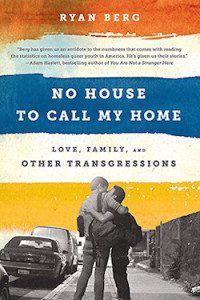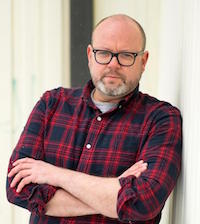
Ryan Berg’s new book No House to Call My Home: Love, Family, and Other Transgressions aims to bring displaced and disabled voices back into the LGBTQ conversation.
A self-described work of nonfiction, Berg’s writing builds on his years of experience as a residential counselor in a group LGBTQ (Lesbian, Gay, Bisexual, Transgender, and Questioning or Queer) home and then later as a caseworker supporting the transition of queer youths as they are “phased out” of the system. As individuals sometimes rendered invisible by both gay and mainstream media, Berg’s project is to inject autonomy and intimacy to their stories so often obscured behind statistics and overlooked by mainstream media.
Berg makes clear that this book is “a work of nonfiction, not journalism.” One of the ways Berg marks the difference between the two genres is by anonymizing the youths’ names and racial identities to protect their privacy. Berg does not want to present an “insider’s” account of life working in these group homes. Rather, he wants the voices and personal narratives from the countless queer and coloured youth to take centre focus—and not be mediated by a white middle-class male.
Berg writes that 40% of homeless youth in New York City are members of the LGBTQ community. But beyond the statistics, Berg wants us to meet some of these 40%. One of the earliest stories is from a young man named Benny. By the age of 16, Benny has been in and out of foster care, caught between different welfare agencies, and shuttled between group homes. As a young child, Benny’s mother abandoned him after one of her drug-fuelled binges. Benny’s biological father was incarcerated for manslaughter and is serving a life sentence. This displacement from a “normal” family—as well as from his father—gave Benny the desire to seek out companionship from older men using a gay phone chatline. With Benny’s story, Berg does not use figurative language to veil his grim reality. Here, he show the reader the rawness of his difficult adolescence.

Berg insists early on that the purpose of this collection of stories is to give agency to queer and transgender teens of color, who are otherwise disempowered by a society interested in the other concerns of the white middle-class LGBTQ movement. In one early passage, Berg writes, “This [book] isn’t a story of a white man attempting to ‘save’ or speak for young queer people of colour.”
Yet, Berg does attempt to intervene in these narratives when he offers his own, somewhat awkward, self-descriptions. When Berg approaches Benny about the stolen credit cards he uses for phone-chatting, Ryan also includes a description of himself making macaroni and cheese, writing: “Steam funnels up and fogs my glasses. I remove them, turn toward him, and wipe the lenses with the bottom of my shirt.” The metaphor seems obvious—Ryan feels sometimes blinded to the problems of the queer youth he is working with—but the description is strained under the weight of Berg’s somewhat dull and superfluous writing.
No House excels when it provides the verbatim stories of the queer youth— unpacking the tragic and painful actualities of their lives and describing how they have become so hardened to the grimness of life. Berg relays the story of Alex, who at the age of five sees his younger brother Lavan accidentally light what they both thought was a firecracker. Lavan has his hand blown off. As it turns out, it was an M-80, a larger explosive device illegal in the United States. The boys had been left alone playing at the apartment of drug-addicted mother’s current boyfriend’s. Alexander explains that since that day he has not seen his mother, nor has he had contact with his maimed brother or father for four years. Stories like these, completely unobstructed by a narrator and written by one of the residents, are powerful and deeply affecting. Alexander’s story proved to be one of the most stirring because not only was it “written” by Alexander, but it underscores the purpose of Berg’s book: to make visible the unseen and untold stories of these marginalized queer youth.
The sheer number of stories of cruelty and pain is sometimes difficult to comprehend. One teenage boy is forced by his grandparents to watch straight porn for hours in the hope that it will cure his homosexuality. The same boy later confides in a high-school guidance counselor about his sexuality, who tells him he should hide his identity. Another adolescent girl is self-destructive, using drugs and alcohol as a way to alleviate the angst and alienation in her life. But after one of the other residents destroys her supply of marijuana, the girl locks herself in the bathroom and sets it on fire. Reginald is a gay teen of color, who is constantly tormented and bullied by other kids at his school. He learns to defend himself, but struggles to stay afloat at school because he must always stay alert or risk another attack. Berg postulates that it is no wonder so many of these teens never receive their high school diploma.
Though he sometimes falters in his storytelling, Berg’s quest to give voice to queer youth of color is a noble one. No House seeks to make visible, the invisible and because of this is an important and revelatory read.




